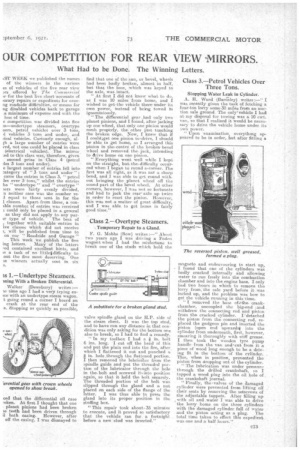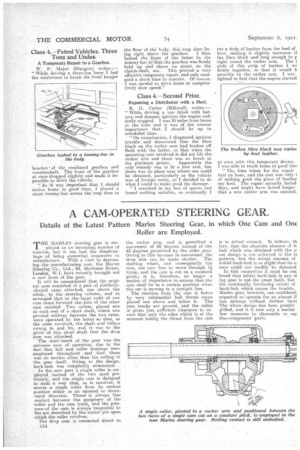OUR COMPETITION FOR REAR VIEW MIRRORS.
Page 9

Page 10

If you've noticed an error in this article please click here to report it so we can fix it.
What Had to be Done. The Winning Letters.
iST WEEK we published the names of the winners in the various as of vehicles of the five rear view )rs offered by 7'4e C 0111111ercial )7: for the best five short accounts of :orary repairs or expedient.s for overag roadside difficulties, or means for ng disabled vehicles back to garage -a minimum of expense and with the loss of time.
e competition was divided into five as—undertype steamers, overtype ners, petrol vehicle) over 3 tons, )1 vehicles 3 tons and under, and rieal vehicles. Curiously enough; al
a large number of entries were red, not one could be placed in class (electrical vehicles). The. mirror ;ed to this class was, therefore, given second prize in Class 4 (petrol des 3 tons and under). • e largest number of entries fell into 2ategory of "3 tons and under "; came the entries in Class 3, " petrol lee over 3. tons," whilst the entries he " undertype " and " overtype " seas were fairly evenly divided, n neither case was the number mei equal to those sent in for the 1 classes. Apart, from these, a contble number of entries was received
could (tidy be placed in a general as they did not apply to any par or type of vehicle. The best of , together -with suitable entries in lye classes which did not receive will be published from time to on our " Roadside and Garage" This week we publish the five
lug letters_ Many of the letters red contained excellent hints, and a a task of no littleldifficulty to out the five most, deserving. One se winners actually sent in six S.
;s 1.— Undertype Steamers.
ming With a Broken Differential.
Walker (Dewsbury) writes :— se time ago I had a very trying exice with an undertype steam wagon. t going round a corner I heard an crash at the rear end of the R. Stopping as quickly as possible, ced that the differential oil case -oken. At, first I thought that one planet pinions had been broken re teeth had been driven through a bath casing. However, after off the casing, I was dismayed to find that one of the sun, or bevel, wheels had been badly broken, almost in half, but that the boss, which was keyed to the axle, was intact.
" At first I did not know what to do, as I was 10 miles from home, and I wished to get,the vehicle there under its own power, instetd of being towed in ignominiously. " The differential gear had only two planet pinions, and I found, after jacking up one wheel, that only one pinion would mesh properly, the other just •tcurching the brokers edge. Now, I knew that if I coub4get one pinion to:drive, I should be able to get home, so I arranged this pinion in the, centre of the broken-bevel wheel and removed the. jack, intending to drive home on one pinion. " Everything went, well while I kept on the. straight, but, the difficulty occurred when I began Co round a,corner. The first was all right, as it was not a sharp bend, and I was able to get round without bringing the planet wheel off the sound part of the bevel wheel. At other corners however, I was riotso fortunate and had to jack the rear' axle up twice in order to reset the pinion. However, this was not a matter of great difficulty, and I was able to get home in fairly good time."
Class 2.—Overtype Steamers.
Temporary Repair to a Gland.
F. G. Mobbs (Bow) writes :—" About two years ago I was driving a Foden wagon l when I had the misfortune to break one of the studs which hold the valve spindle gland on the H.P. side of the steam chest. It was the top stud, and to have run any distance in that condition was only asking for the bottom one also to break, so I had to find a remedy.
"In my toolbox I had a in. bolt 6 ins. long. I cut off the head of this and put the plain end into the fire after which I flattened it out and punched a in. hole .through the flattened portion. I then removed the lubriealor trim the spindle guide and put the threaded portion of the lubricator through the hole in the bolt and screwed it. into position again, so that it held the bolt securely. The threaded portion of the bolt was slipped through the gland and a nut placed on each side of the flange of the
latter. I was thus able to press the gland into its preper position in the stuffing box.
"This repair took about, 35 minutes to execute, and it proved so satisfactory that the vehicle ran for, a fortnight before a new stud was inserted."
Class 3.—Petrol Vehicles Over Three Tons.
Stopping Water Leak in Cylinder.
A. H. Ward (Barrrsley) writes was recently given the task of fetching a four-ton lorry some 30 miles from an auction sale ground. The only vehicle I had at my disposal for towing was a 10 ewt. van, so that I realized it would be necessary to drive the vehicle home under its Own power.
Upon examination, everything appeared to be in order, but after fitting a
magneto and endeavouring to start up, I found that one of the cylinders was badly cracked internally and allowing water to run freely into the combustion chamber and into the engine base. I only had two hours in which to remove the lorry from, the sale yard before it was locked up, and the problem was how to get the vehicle running in this'time. "I removed the base ofJ the. crankchamber, uncoupled the big-end -.and withdrew the connecting rod and piston irons the cracked cylinder. I detached the piston front the connecting rod. replaced the gudgeon pin and inserted the piston (open end upwards* into the cylinder from underneath, first, however, smearing it, thoroughly with stiff grease. I then took the wooden tyre pump handle -from the van androut from it, a piece of wood long enough to be a driving fit in the bottom of the cylinder. This, when in position, prevented the piston from dropping out of the cylinder_
" The lubrication was under pressure through the drilled crankshaft, so I tapped a wood plug into the oil hole of ; the crankshaftjournal. .
"Finally, the)valves of the damaged cylinder were prevented from lifting off their seats by removing the setscrews of the adjustable tappets. After filling up , with oil and water I was able to drive the lorry home on the three cylinders with the damaged cylinder full of water
and the piston acting as a plug. The total time taken to effect this expedient was one and a half hours."
Class 4. –Petrol Vehicles, Three Tons and Under
A Temporary Repair to a Gearbox.
W. F. Major (Glasgow) writes :— " While driving a three-ton lorry I had the misfortune to break the front hanger
bracket • of the combined gearbox and countershaft. The front of the gearbox at once dropped slightly and made it impossible to dril7e tlae vehicle.
"As it was important. that I should arrive home in good time, I placed a stout tornmy-bar across the trap door in the floor of the body, this trap door be ing right above the gearbox. I then lashed the front of the latter to the tommy-bar so that the gearbox was firmly held up and threw no strain on the clutch-shaft, etc. This proved a very effective temporary repair, and only occupied a short time to execute. Of course, was careful to drive home at comparatively slow speed."
Class 4.—Second Prize.
Repairing a Distributor with a Heel.
R. G. Carter (Millwall) writes ;— " While driving a van fitted with battery and dynamo ignition the engine suddenly stopped. I was 30 miles from home at the time and it was of the utmost importance that I should be up to scheduled time.
"On examination, I diagnosed ignition trouble and discovered that the fibre blqck on the rocker arm had broken off flush with the latter, so that when the operating cam revolved it did not lift the rocker arm and there was no break at the platinum points. Apparently the only remedy was to fit a new arm, but there was no place near where one could be -obtained, particularly as the vehicle was of foreign make, so I decided to do what I could to make good the 'damage. " I searched in my box of spares and found nothing suitable, so eventually I cuta strip of leather from the heel of boot, making it slightly narrower ti the fibreblock and long enough to p right round the rocker arm. The t ends of this strip of leather I wi firmly together, so that it would h securely on the rocker arm. I was lighted to find that the engine started at once with this temporary device, I was able to reach home in good firm " The time taken for the repair half an hour, and the cost, was only t of making good the piece of leather my heel. The repair actually lasted days, and might have lasted longer that a new rocker arm was secured.
































